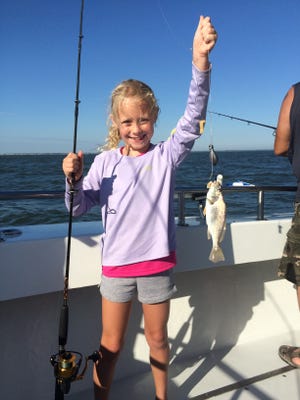Croakers are harder to find, small when you catch them

“Life is a lot like jazz. It’s best when you improvise.” — George Gershwin
Just when you think you have the whole summer fishing thing figured out the darn things move (or don’t show up). For years, we have had some decent fishing for panfish such as croakers in the late summer months. The last few, however, have shown a decided downturn in the numbers of these scrappy fish, and this year they have been very, very scarce, leaving a dearth of bottom fishing for bay boats.
The reason for the dearth of spot and croakers is undoubtedly multi-causal. The water in the bays has been pretty cool for most of the summer with temps only in the mid to low 70s in July. The water has been murky at best and in the Delaware Bay parts of the bottom substrate have been worked over by whelk and crab dredgers during the colder months, which any sensible person could postulate would deleteriously impact bottom fishing. Both of these fish are fast growing species and are susceptible to all sorts of variables and vagaries.
But with a more robust temperature, there have been more and more croakers in Delaware Bay and its tributaries. Now for a cautionary note. They are not keepers. Not even the keepers, really are keepers, measuring barely eight inches (the legal size) and most falling under that. Croakers are mainly head at that size, looking for all the world like a silvery tadpole. The good thing is that they grow fast! Hopefully, there will be enough food left on the scraped bottom to hold them.
The canal in Lewes has been affording anglers some bigger croakers to work on, as well as some nice spot. These fish can be caught with a small number six hook and either real or artificial bloodworms. Small bits of squid or clam also tempt these fish.

Elsewhere, flounder action continues to be good for anglers working some areas of the Old Grounds out in the Atlantic. According to Capt. Rick Yakimowicz on the all-day headboat out of Fisherman’s Wharf in Lewes, things have stayed on track.
"Last week’s easterly winds pushed some really pretty, clear water all across the Old Grounds,” Yakimowicz said. “As a result, anglers have not only enjoyed good fishing but have been able to see their fish coming up from the depths from nearly 40 or 50 feet below the surface!”
READ MORE:
Conditions make flounder fishing a dice roll
Inshore flounder action gets hot along Va. coast
The savvy skipper passed along some familiar faces with limit catches from the week, with repeat performers Marc Levinrad, Jeff Scurti, Donna Nortin, Bob Trento and Bob Murphey landing limits, along with Marti Byler and Dr. Kenny Philbrook. Another angler, Edwin Maxwell, scored a limit of flounder and a bonus dolphin to boot!
Capt. Carey Evans on the Lewes charterboat Grizzly also reported a good catch, icing down a bunch of bass and 25 keeper flatties on a recent charter to the ocean.

Bouncing bucktails laced with Gulp! have tempted many a flattie off of the bottom and into a cooler. Tipping the jig with a strip of cut bait sliced from a smooth dogfish or sea robin can also tilt the odds on your favor. Some fish have also come from Delaware Bay rubble and, Old Inlet reports, from around the rocks of the inlet.
The suds have been yielding the normal summer fish such as small snapper blues, small kings, the occasional small croaker and spot. Sometimes anglers will land a nice trout as there have been more of them around, as well as the odd flattie. Small hooks with bloodworm or clams are the way to go with the kings and mullet chunks for the blues.
Comments, questions or reports to captjackrodgers@comcast.net